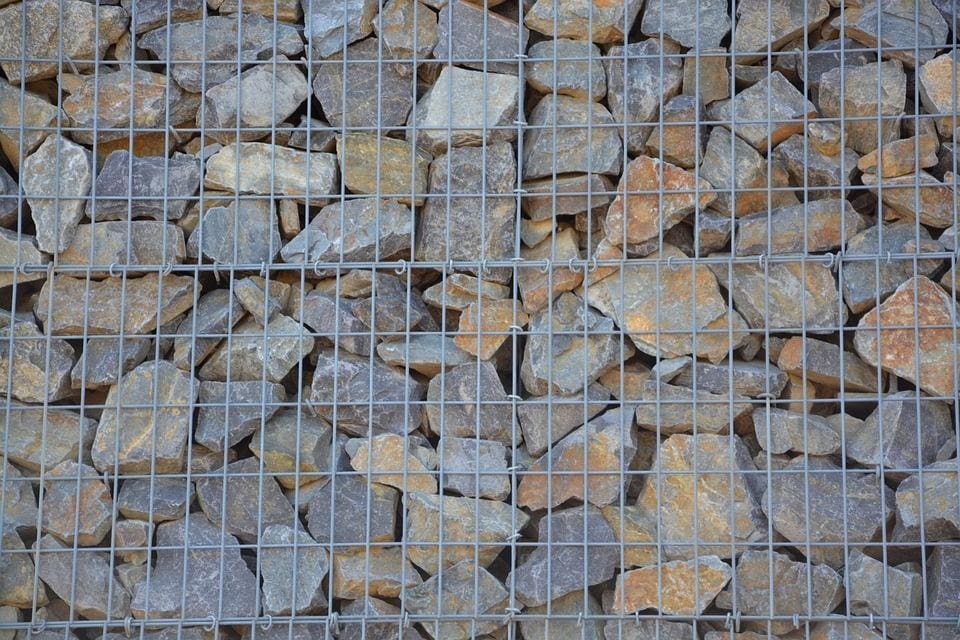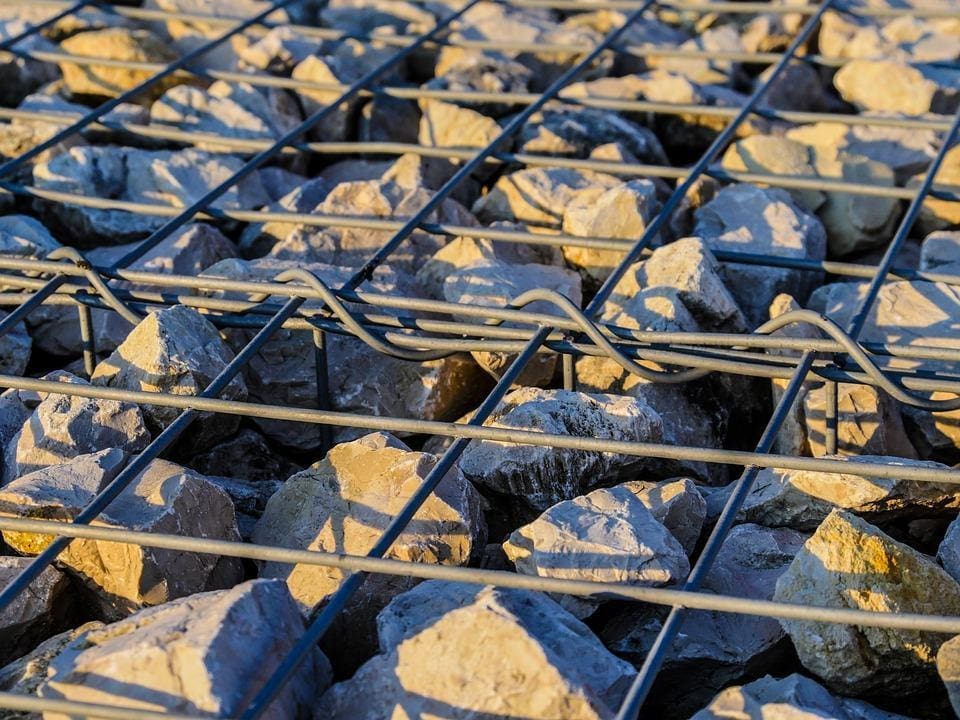Urban and Rural Uses of Gabions
Gabions are cages traditionally made of wire mesh panels used to contain stone or some other fill material. The wire mesh is usually a twisted wire mesh or welded wire mesh construction and provides a high strength basket that holds the stone together allowing you to create a retaining wall, a gabion fence, a screen wall, or even a bench or fire pit. This guide will walk you through the different types of gabions, uses for both urban and rural applications, and the many benefits of utilizing gabions.
In general, gabion uses are divided into Civil or Erosion Control Applications versus Architectural Applications with opportunities for both in urban and rural locations. Civil and erosion control uses of gabions include gravity retaining walls, MSE walls, slope protection, shoreline protection, check dams, bridge protection, channel lining, bioswales, and culvert outlet protection. Architectural gabion applications include gabion fences, landscape walls, screen walls, and gabion elements including benches, fire pits, and columns.
All of the architectural and civil gabion applications can be just as at home in both urban and rural locations. As long as you take the time to match the cage and fill material with the environment, gabions can be the right fit for your project
Types of Gabions
Gabions are divided into different types based on the material used to make the mesh, the construction of the mesh, and the size and use of the gabion.
The highest level division of gabions are gabion baskets, gabion mattresses also known as reno or revetment mattresses, and specialty gabions.
Gabion Baskets
Baskets are the most common style when constructing walls and other gabion elements and are generally over 1’ in height and are 1’ to 4.5’ in width.
Gabion Mattresses
Mattresses are named that because they resemble a mattress like you sleep on at night. Standard mattresses are 6”, 9”, or 1’ in height and 6’ in width and 9’ or 12’ in length and are generally used for surface reinforcement like on a slope or as a base to provide a larger footprint at the base of a wall to prevent scour.
Specialty Gabions
Gabion Pillows are small gabion units that are generally light enough to move by hand even once filled that are perfect for hard to access areas where getting machinery in is difficult.
Gabion Sacks act like large marble sacks that contain aggregate and can be used with lifting slings to place the filled sacks with minimal labor.
Gabion Cylinders utilize a single sheet of gabion mesh wrapped in a cylinder formation and secured along a single seam. This is generally used in shoreline or similar reinforcement where you need a column of confined aggregate.
Gabion Elements are creative elements utilizing gabion mesh to construct columns, fountains, fire pits, benches, etc.
Advantages of Gabions
Gabions can be used for all sorts of purposes and have many uses that give them an advantage over other structures. Many of the advantages are equally useful in both civil and architectural applications as well as urban and rural applications.
Aesthetic look
The diversity that gabion structures provide offers the ability to be creative in a way that normal concrete or brick structures do not provide. Having the freedom to create different walls and structures utilizing different mesh and fill material options gives you the freedom to make them look decorative and attractive. This makes them suitable for urban areas where they are installed to beautify the landscape. Gabions visually compliment their outdoor surroundings and ensure that the style looks consistent and has a natural feel.
Ease of installation
The installation of gabions is another benefit of them, as they are easy to build and do not require an artisan's touch. While labor intensive with a little time and patience you can have a professional looking wall with little to no experience.
Affordable
Gabions are relatively cheap structures when compared to other types of walls. This is especially the case when they are compared to gravity concrete walls. They are also more affordable when utilizing onsite fill material from either existing stone on site or from utilizing recycled material such as demolition material during renovation projects.
Water permeability
Another attribute of gabions is that they are made of wire and filled with stone so they contain open voids allowing water to pass through. This greatly reduces the hydrostatic pressure behind the wall.

Soil protection
One of the most important benefits of gabions is that they are often used to create barriers preventing erosion and protecting the soil from different climatic conditions. This makes them suitable for places like coastal regions where they are used to protect the shoreline. They can also be used on steep slopes with high water volume where the baskets or mattresses can be used to hold soil in place while also providing a textured surface to reduce water velocity.
Longevity and durability
Since gabions are generally used in locations that have minimal traffic, they are relatively durable and can last for a long time, even under harsh weather conditions. Gabions should be manufactured in accordance with ASTM specifications that require high levels of galvanization and high quality PVC coating when PVC coating is required. The levels of galvanization and PVC coating found in gabions manufactured in accordance with ASTM specifications are suitable for a variety of site conditions and are built to last.
Lightweight
The gabion mesh or framework is fairly lightweight and collapses for shipping allowing for easy shipment and storage until they are ready to be filled. The cages also allow you to utilize locally sourced fill material minimizing the volume of material needing to be transported long distances when compared to retaining wall blocks or concrete.
Flexible and customizable
The wire used in gabion structures is relatively flexible and easy to work with. This makes them suitable for use in various types of applications. They are also highly durable and have a relatively low rate of breaking when installed. The mesh construction, especially in welded wire gabions, allows gabions to be constructed in custom dimensions as long as they are in even increments of the mesh aperture dimensions.
Environmental friendliness
Gabion structures are relatively cheap and can be reused repeatedly. It makes them environmentally friendly as they do not require a lot of space for storage and transportation. They can reduce the volume of concrete needed in construction projects making them more sustainable. Gabions can also be filled using recycled material from the site reducing the amount of material needing to be hauled away during renovations. They can also be recycled when they are removed from the site. It makes it easier to restore the land and create good ecological conditions. The stone filling of gabions also provides a great media to contain and trap soil particles protecting waterways from the negative effects of silt and fine particles entering waterways.
Help prevent sliding and washouts
Gabion structures on slopes and in drainage channels help to create a barrier that prevents soil erosion on the surface at the location of the gabions and can act as a velocity dissipator to slow down water flow rates helping protect soils further downstream.
Noise protection
The gabion structures can help to absorb sound. It makes them ideal for use in public spaces such as parks where noise pollution can be a real issue or as a fence separating residential properties and busy roadways. Gabions allow a quieter, more homey feel for areas like parks and communities while fitting into the scenery.

Conclusion
Gabion structures can be installed in any area and for a variety of reasons. The mix of practical applications with a beautiful aesthetic provide a perfect building block for your project. Whether you are considering a structure for urban or rural use, this article hopefully provided an introductory insight to gabions and how they can be used to make your idea come to life.
